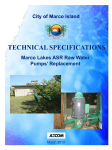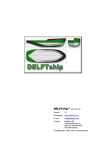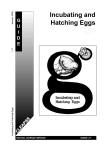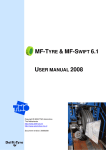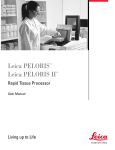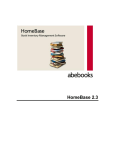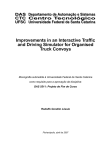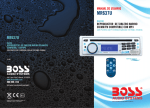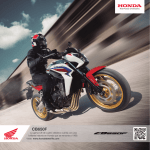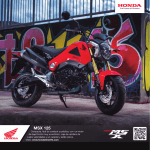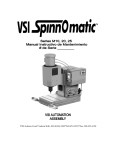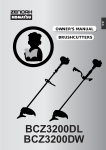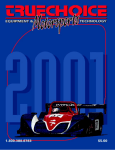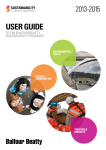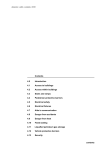Download Winter 2010
Transcript
The Newsletter of Borders Group of Advanced Motorists Borders Observer Issue 25 Office Bearers Peter Sandison Chair Tel: 01896 758634 [email protected] Morag Sterrick Vice-Chair & Events Co-ordinator Mob: 07703 399855 [email protected] Bill Allison Secretary Tel: 01750 22550 Mob: 07768 511931 [email protected] Andrea Pogson Treasurer & Membership Sec. Tel: 01896 850759 [email protected] [email protected] www.bordersiam.org.uk Winter 2010 Borders Group launches Young Driver Initiative An exciting local road safety initiative has been launched to help counter the alarming number of collisions involving young drivers under 26. Borders Group of Advanced Motorists have received generous support from Volvo and Jaguar dealer Clelands of Galashiels to enable young drivers from the Borders to improve their driving skills and better equip themselves for the roads. Drivers under 26 are involved in a disproportionately large number of road collisions, with the youngest drivers at even more risk. The riskiest time for all new drivers is the first year after passing their driving test and the numbers involved in collisions fall with each added year of experience and maturity. Young men are twice as likely to be involved in collisions as young women. There are a number of circumstances in which such collisions result in injury or death. They include older cars being involved with poorer levels of crash protection, three or more casualties in the car and collisions at night and at weekends. Single vehicle accidents on rural roads are common. These circumstances are associated with a combination of factors, such as inexperience and poor judgement, poor car control and lifestyle factors including peer group pressures. Continued on page 3... Accident Investigator Also inside... ● About us ● Event reports ● Knockhill day ● Test passes ● Member profile ● Road-test ● Winter car care ● Situations Vacant ● and more... About Borders Group Who we are Borders Group of Advanced Motorists is a voluntary organisation with charitable status affiliated to the Institute of Advanced Motorists. We currently have approaching eighty members - of all ages, and from all walks of life. "Full members" have all passed the IAM Advanced Test and are in continuing membership of the Institute and can support the work of the IAM locally through the Borders Group. "Associate members" are preparing to sit the Advanced Test. "Observers" are members of the Group who have already passed the Advanced Test and have taken part in a training course to enable them to coach new Associate members in the skills they have achieved. The Group is a run by a Committee of Full Members, who give generously and willingly of their spare time to the cause of Advanced Driving in the Scottish Borders. Our aims • help members improve and enjoy their motoring more • contribute to the safety of other road users through our members improved standards! • hold regular meetings and events promoting safer driving • encourage all drivers to become "lifelong learners", as the perfect driver has yet to be born! What do we do? Our activities focus on: • the running of regular courses for new members preparing for the Advanced Test • a programme of regular meetings which normally have a motoring-related theme • giving free "demonstration" * drives • offering free "assessment" ** drives • publicising the work of the Institute at events • giving free presentations to local organisations, clubs, etc., on advanced driving and related issues * In a "demonstration" drive one of our Observers will take you out (for up to half an hour), to let you see what's involved and give you an explanation of what Advanced Driving is about. ** In an "assessment" drive one of our Observers will accompany you in your car, offer practical advice on your performance, and suggest where improvements could be made. The Observer might even persuade you to join the Group! Why become an Advanced Driver? In the UK as a whole, the number of those killed and those seriously injured in road collisions have both reduced by 40% over the past ten years. In the Scottish Borders that has not happened - neither number has reduced at all in the same period. The only logical conclusion one can draw from this is that the Scottish Borders is an unusually hazardous area in which to drive, or Borders drivers are relatively unskilled... However, statistics also indicate that on average your chance of having an accident is cut by two-thirds if you pass the Advanced Test. If you are a young driver (under 26) the improvement can be many times this. Your fuel and maintenance costs will reduce, and at the same time the skills you learn will get you from A to B more quickly than the untrained driver. You are likely to be eligible for significant insurance discounts. Advanced Drivers set an example to others, are courteous, and enjoy their motoring more. If every road user passed the IAM Test and practised its standards at all times, there would be a dramatic fall in the number of road collisions in the Borders. www.bordersiam.org.uk www.iam.org.uk Young Driver Initiative (continued from front cover) The support from Clelands will enable initially ten young drivers to team up with Borders Group of Advanced Motorists volunteer Observers, who will coach them towards their advanced driving test. Despite his successful background in motor sport John Cleland is keen to stress the importance of young drivers developing their skills with the emphasis on responsibility, which goes naturally with the Institute of Advanced Motorists key message that skill with responsibility is a skill for life. The initiative is open to any driver under 26 years of age who is normally resident in the Borders, who has held a full UK driving licence for at least 3 months and has no driving related court proceedings pending. Places will be allocated on a first come first served basis. The young drivers must pay for the Institute of Advanced Motorists “Skills for Life” package at £139, which will be refunded on passing the Advanced Driving Test at the end of the process. There is nothing wrong with an exhilarating drive through a fast-flowing series of bends in the country, or driving “with a sense of purpose” in town, city or on a busy motorway, when it is done safely, but the advanced skills necessary to do those things safely are not taught to new drivers. Too often the combination of lack of training and the impulsiveness of youth is this... (Note: On this occasion the occupants were lucky and escaped serious injury) Anyone 25 or under wishing to take advantage of this outstanding opportunity, or to ask for more information, may contact any Committee member using the contact details on the front cover. Event Reports 2009 Annual General Meeting Pictured above is Constable Rory Campbell of Lothian and Borders Roads Policing Division, during his presentation at our well-attended AGM in May. Rory privileged us with an insight into the very demanding aspects of the work of Roads Policing officers involved in collision investigation. After a fatal or near-fatal collision this work includes meticulous analyses of the crash scene, working back to determine the sequence of events leading up to the collision, liaison with other agencies and the unavoidably harrowing task of informing victims' relatives of the event and helping to provide them with counselling and support as the investigation proceeds. His detailed presentation, assembled with the permission of the victim's immediate relatives and including sobering footage of statements by them, covered a recent fatal collision in the Borders and attracted many thoughtful questions from those present. Visit to Chain Bridge Honey Farm One of our “away days” and one of the best. We expected this to be a guided tour of Messrs Robsons business, which it was, and interesting enough on that account. What we did not expect was to find a collection of 2, 3, 4 and more wheeled and tracked vehicles and associated memorabilia, in various stages of restoration ranging from untouched since being found in the proverbial barn somewhere deep in English territory, to fully and immaculately restored to original condition. Our visit was made all the more enjoyable by our hosts' obvious passion and energy for both the expanding “day job” side of the business and building up their extensive motoring museum. Our visit was rounded off by excellent homemade refreshments in the “cafeteria”. (Editor's note – lots of photos because none of them deserve to be excluded!) The Honey Farm products showrooms. Note the murals top right and below. There were many more. The “Cafeteria” Vehicles and motoring-related (mostly!) memorabilia Yet another superb mural and finally – Dad's Army... posters and transport Driver Skills Day at Knockhill - an account by Irene McKeon I was eagerly anticipating the IAM Skills day at Knockhill until the “Disclaimer” arrived, “Motor Sports can cause injury or death”: result - cold feet! The cold feet turned into a distinct overall chill when I eventually arrived at Knockhill and saw the bikes racing around the track. Was this really for me? After a very friendly welcome at check-in, I made my way over for coffee and promptly lost my display letter “D” (for “Dunce”, perhaps?)! Having been reunited with my “D”, I joined the other group members for a safety briefing. Now hypothermia was really setting in as we were told about rules, flags, overtaking and accidents. Fortunately an instructor is always in the car when you are on the track. Next I met my instructor, Jim, and fellow driver (victim?) Ian. We were working on a ratio of 2:1. Jim immediately put us at ease as we made our way to the cars. Because both cars were 4-seaters we decided to ride as observers when not driving. This proved to be a good idea as we had twice as long on the track - watching, listening and learning - as those with 2-seater cars. I was first to drive the course, which is short, but very demanding: none of the usual indicators of line such as hedges and telegraph poles. We spent the next 2½ hours on track, practising position, gear changing and steering. This was very enjoyable with no pressure to do more than I felt able, although I could have chosen to push my car to its limits as the owners of the sports cars did. Jim gave a demonstration drive in a new Alfa Romeo Giulietta, and later I was able to take it around the track for a few laps. Great fun, and a lovely car to drive! All too soon it was time for the final debriefing. Everyone was smiling and appeared to have enjoyed themselves immensely. My only criticism was that I would have liked to have had more time. The cars got a late afternoon slot because of the small numbers, only 11, compared to the bikes. My last question was, “When is the next Skills Day?”. I now know that it has been scheduled for 29 th June 2011. Do go along if you can. The organisation is professional, but at the same time informal and friendly. No pressure, but plenty to learn and lots of fun. And my initial “cold feet”? Completely replaced with a warm glow of enjoyment! The “Bible” As a keen advanced driver and someone who has always loved books, it was only a matter of time before I set out to try and collect the various editions of 'Roadcraft', the police drivers' manual, the bible on which all advanced driving is based. Oblivious to cries of “anorak” from elsewhere in the house, I started out. The first, and for most people, the only version of Roadcraft they might own is the version that was current when they were preparing for their IAM test. In my case this was the blue cover version published between 1994 and 1997, with the “jam sandwich” stripes on the cover's patrol car. This version was a significant change in both content and presentation from its predecessor and became known as the “new version”. It presents the system of car control as we all know it, based on Information, Position, Speed, Gear and finally Acceleration. The complementary video/DVD was published alongside this version. The previous version was first published in 1977 and the cover drawing of the interior of a police car, viewed from the back seat, immediately seems to come from an earlier world. This edition was found locally in a library book sale and at around 90 pages was only half the size of its successor. It retailed at £1.95, a snip compared to its successor's £11.50! The illustrations are, in the main, line drawings and relatively simple. It is the application of the system that forms the main difference in this version, starting with Course, then Mirrors, Signals and Speed, Gear, Mirrors and Signals, Horn and Acceleration. General advice and 'ten commandments' finish this version. My current pride and joy is the first edition 1960 version, which I managed to win in an Ebay auction for the princely sum of £1.20 plus postage! For a fifty year slim book it is in remarkably good condition and retailed in 1960, through HMSO, at three shillings and sixpence, or 17.5p for the younger reader. The cover is navy blue with a Wolseley police car, complete with bell, instead of siren and roof mounted loudspeaker. For those of us old enough to remember, a proper, black police car as you might expect to see Superintendent Lockhart arrive in during an episode of 'No Hiding Place'. For all its age this version contains a very good diagram of how to best position the car for a series of bends, which, arguably, has not been bettered in later editions! A trawl through the excellent 'Abebooks' web site (a huge network of independent booksellers) identified a copy of the 1974 version with the 'Sweeney' Rover P6 on the cover. As I write this it is, I hope, in the post. More of that in the next issue! Martyn Buckley Test Successes Congratulations to all Borders drivers who have recently passed the IAM Advanced Test. Here are some photos and a couple of brief accounts: Advanced "Driving" for Golf stars Fiona Whittet, one of our most recent successful test candidates, came to advanced driving through a most unusual route. In 1992 Fiona became a courtesy-car driver for major golf tournaments in the east of Scotland, including the Alfred Dunhill Links Championship, the Open, and the Scottish Open. One year the pre-tournament briefing from the suppliers of the Lexus Hybrid courtesy cars included driving advice that Fiona realised was sound, and made her think about doing an advanced driving course, and this was reinforced when she heard that it would be mandatory for drivers at this year's Dunhill Championship to be advanced drivers. So the motivation was strong, and having purchased the IAM's “Skills for Life” package and enrolled with Borders Group she duly made good progress as an Associate, passing her test on September 18th, some three weeks before the Championship. Fiona receiving her Test Pass certificate from Secretary Bill Allison Her Observer, Peter Sandison, tried to get the low-down on the top names in golf, but no amount of arm-twisting could persuade Fiona to divulge any secrets. He has, however, asked her to suggest to Tiger the next time they meet that he considers doing advanced driving - in the motoring sense: it might bring his insurance down! Congratulations to Fiona, and many happy future years of advanced courtesy car driving! Jim Peat shares a joke with his Observer Bill Allison during his recent Test Pass certificate presentation “Mother and Son” We are Euan and Karen and we joined the IAM as Associates in 2009, Euan as a young driver, recently passed his driving test, and encouraged by Events Organiser Morag Sterrick to become a member, Karen as a driver who had always intended to join the IAM but had not quite managed to get round to it! We both attended induction days in October and started with our Observer, Bill Allison, soon thereafter. The first drive was a bit daunting but we were soon introduced to the IAM techniques, and commentary. We also had plenty reading material - the IAM Handbook and the Police Roadcraft manual, and the Chris Gilbert DVD “Ultimate Driving Craft” came highly recommended. We steadily became more confident and the commentaries improved - we were told that in winter, there is so much more to spot when there are no leaves on the trees, though some of our planned drives had to be postponed due to the severe weather. We were lucky to meet PC Sharon Lackenby at the Ladies driving event in March, organised by Morag, and benefit from her input and comment, as a Roads Policing Officer. After sending off our test application forms, we were contacted by Tom Cowper who was to be our examiner. Test dates were arranged for 14th April, starting from Lauder. Tom put us at ease before we started driving and the actual test was really quite enjoyable. Our routes included A68, A7 and Edinburgh City Bypass. We are very pleased to say we both passed and received favourable comments on our drives. Our Observer received compliments for having us both very well prepared for our tests. Many thanks to all who helped us. Karen and Euan Craig. Euan and Karen receiving their Test Pass certificates (Editor's note: Euan is the youngest Borders driver ever to have passed the IAM Advanced Test, and scored top marks for all aspects of his drive, which is remarkable at any age.) My IAM Driving Assessment My name is Neil Dickson and I recently celebrated my tenth anniversary as an IAM member. I decided to mark the anniversary by taking an IAM Driving Assessment. An assessment takes the same form as the advanced driving test, but it’s not a pass or fail exam and does not put your membership at risk. Instead, the examiner observes your driving under test conditions and gives you feedback. I have now taken my assessment, and I feel the whole experience has been beneficial. When I started to prepare for it, I realised I had become complacent. I was almost saying: “I am an IAM member. So I know I am an excellent driver.” In fact, my skills had deteriorated – not dangerously so, but I had definitely lost some of the finer points of advanced driving. A session with Bill Allison was very helpful in identifying areas of my technique that needed work. I then worked on these over several weeks whenever I was out driving. Then came the assessment. The examiner was, as ever, very friendly but missed nothing – good or bad. I was pleased to learn that, if it had been a test, I would have passed. The examiner gave me useful advice on the things that had not gone too well, and was generous over the good points. I think the message to all of us who have been IAM members for a long time is this. Don’t be complacent. Realise that your driving skills deteriorate over time. Like your car, they require regular maintenance. An assessment is an excellent way to do that. Neil Dickson Member Profile - Martyn Buckley Age 54 Semi Retired after 35 years in local government finance Borders IAM – Vice Chair, Observer and former Treasurer Passed 'L-Test' at 17 in the black and white days (1973), learning in an Austin 1300. Soon after I bought my first car, a 1965 Ford Anglia, for the princely sum of £65, and then had to pay £56 to insure it. (As my dad was a policeman at the time I thought I ought to do it all by the book!). Thinking about it, the first references I heard to advanced driving, the System and Roadcraft were from my dad. The Anglia taught me how to limp home on a wing and a prayer (i.e. 3 cylinders) and rudimentary patching work with filler. I remember, quite clearly, having to pay the scrappy £3 to take it away! Since then I have worked through a Vauxhall Chevette, Ford Escort, Ford Orion, Ford Sierra, two Vauxhall Cavaliers, an indescribably awful Vauxhall Vectra, a Saab 9000 CLS, a Volvo S40 T4 (great fun, if not wholly reliable), a Volvo V40 diesel and am currently driving a SEAT Leon FR 2.0 TDI. This is a great combination of fun, performance and economy, especially having had the ECU remapped! Unlike the Group Secretary I have no mechanical, technical or practical bent whatsoever! Like many people I had meant to have a go at advanced driving for years and eventually got round to it. I passed the IAM advanced test in January 1998, thanks to my Observer, Elliot Oliver. Our former Chairman, Raymond Black, bent my arm to have a go at the ROSPA test and I have travelled to Fife three times to date for the test and regular re-tests, being fortunate to gain Gold Grade each time. Having thought about it, that's three ROSPA tests in three different cars. My driving ambitions are to continue to improve and at some point own an Aston Martin. Since my dad took to me to the cinema at age seven or eight to see Goldfinger, it has always been an Aston for me; you can keep your Ferraris and Lambos! Other interests include listening to music, reading (very widely), most sports, especially football and cricket and any excuse to go for a drive. Keen fan of both Leeds United and St Johnstone Football Clubs, so double the grief and stress on a Saturday afternoon. Faults? Too many to list but include impatience, intolerance, and was once described by a former colleague as “an awful snob”, to which I replied “I thought I was quite good at it!” Situations Vacant Heeeeeeeeelp! We need a Newsletter Editor. It's not difficult and it needs only a few hours, four times a year. All you need is a computer – PC or Mac is fine. We'll supply easy-to-use software and pre-designed layout templates. All you have to do is assemble the content and, where necessary, tidy it up. The reward is the knowledge that you are an active part of our efforts to accelerate membership growth and thereby help reduce the numbers killed and seriously injured on Borders roads. Please get in touch. My contact details are on the front of this Newsletter. Bill Allison Winter Car Care Here is a collection of car-care and driving tips with a winter focus. Winter-specific items are in blue... Vehicle suitability: In winter consider fitting winter or all-weather tyres but be aware that on warm dry roads winter tyres provide less grip than normal tyres and all-weather tyres are a compromise - not as good in winter as full winter tyres and not as good in summer as normal tyres. If your vehicle has relatively wide wheels and tyres consider fitting narrower wheels and winter tyres to provide best grip in snow. Inform your insurance company if you do change anything as it might fall within the class of modifications which you are required to inform them about. If your vehicle is under warranty, ensure that you use only manufacturer approved parts. Be aware that most ABS systems do not work well on snow and ice and can considerably extend already lengthy braking distances. Re-read your vehicle user manual and note any warnings relating to ABS and other electronic stability aids' behaviour on ice, snow and uneven surfaces. Vehicle contents checklist: Torch with fresh or recently charged battery Tow rope Warning triangle as large as you can make room for First aid kit unopened High visibility jacket Jack 9” x 9” steel or 3/4” ply plate to enable the jack to be used on soft or uneven surfaces Wheel-brace Piece of steel tube to extend the wheel-brace handle for extra leverage but only to slacken nuts, not to tighten them Locking wheel-nut key if your vehicle has anti-theft wheel-nuts Spare bulb kit – two of everything (modern bulb manufacturing consistency is such that two bulbs of the same type may often fail within hours of each other) Vehicle instruction manual (but read it and know in advance how to change bulbs) Clean absorbent cloth to demist window interiors De-icer (be careful to store it upright – the containers tend to leak and the contents are highly inflammable, and you don't want to find it empty when you need it) Flexible scraper for curved surfaces such as headlamp and rear lamp lenses. For any journey in snow: Shovel or spade (the latter is better at digging out refrozen snow-melt) Gloves For any journey out of town in snow: Blankets Clothing and footwear suitable for working or walking in snow Thermos of hot soup (one per occupant) Bottled water or fruit juice Mobile phone and in-vehicle charger Location and phone numbers of en-route motels (most of them will now let you book in advance and not charge for a cancellation before 4pm, so consider booking a room at strategic locations enroute “just in case”) Road atlas A 12vDC to 250vAC inverter is a useful option to run equipment such as phone and torch battery chargers, hair dryer (to thaw wiper blades, door locks, etc – but don't point it at a window), etc Soft floor brush to clear the snow off your car in the morning (if you have room and your journey includes an overnight stop) Daily checks - before the first drive each day: After overnight rain use a chamois or similar to remove excess water from the roof. You do not want it cascading down the back window when you pull away, or down the windscreen the first time you decelerate. After overnight frost thaw the vehicle thoroughly – a long extension cable and 3Kw fan heater placed inside for 10 minutes will do a good job. In extreme conditions, unless theft is a concern, also start the engine and set the car's heating to full screen heat and to recirculation mode to quickly spread the warmth around the cabin. Defrost lamp lenses and mirrors if not electrically heated. Flex wiper blades to free up frozen joints then immediately spray them generously with deicer. After overnight snow, initially do not remove the snow. Thaw the vehicle as above and the insulating effect of the snow will allow the roof and bonnet to warm up quickly and melt the snow close to it. The snow can then be cleanly pushed off with a soft-bristled floor brush. Remove all of the snow. Snow can slide forward off the roof when you decelerate, blocking your view, or blow up from the bonnet and do the same. Blocked air inlet grilles can rob the cabin of air, making the windows steam up inside, or at worst incapacitate you. Refrozen snow (ice) coming off the roof at speed could injure a pedestrian or cyclist or cause an accident. If you didn't do so after the previous day's driving, remove the snow accumulated and now frozen around the wheel arches otherwise it can come off as you drive, causing distracting thuds or even damage to under-wing plastic shields or other parts. Carefully clean all windows outside. Even if they look clean you won't see through them, with a day's road grime on them, against a low winter sun. Check all windows are clean inside. Clean them once a month even if they look perfectly clean. Unless your car has filters in its ventilation system, the windscreen particularly becomes coated inside with oil and particles from other vehicles' exhausts, which at night creates a star-burst glare effect around car lights and street lamps. Clean mirrors, all lamp lenses and number plates. If your car has a lot of front bright-work, give that a wipe too. Anything to make your vehicle more conspicuous. Remember the second most common thing drivers say after an accident is “I didn't see him” or “He just came out of nowhere” or similar. And of course in daylight you always drive with dipped headlamps on, don't you? Buses always drive with headlamps on because other drivers fail to see them. Buses. Think about it. “POWDER” checks: Petrol (or Diesel) – ensure sufficient. If diesel, and the overnight temperature was below -15°C, run the engine for 10 minutes to lift the underbonnet temperature. That will warm the fuel filter and increase the chance of melting any wax crystals that have formed in the fuel which would otherwise accumulate, block the filter, and stop the engine. In extremely cold weather, it will also warm and thaw the screenwash fluid in container, hoses and bonnet-mounted jets. Oil – whilst it could be argued that once a week is sufficiently often to check oil level, it does no harm to check it daily, always with the vehicle on a level surface. If an oil seal does fail you then have a good chance of detecting it before the oil level has dropped to the point where damage would occur. This item doesn't just cover engine oil. Check brake fluid – if there is a perceptible drop from one day to the next on no account drive the vehicle. Check clutch fluid also if the clutch is hydraulically rather than cable operated. Water – In a modern vehicle the water level, checked when the engine is cold, should not change from day to day. If it does drop then you have a water leak that needs to be found and fixed. Screen-wash bottle – make sure it's full and has a sufficient proportion of screenwash additive for the temperatures expected. Defects – Just look for trouble. Walk around the vehicle. Look around the engine bay. Look for anything broken, loose or out of position - wheel trims, body trim, grille, fog lights, exhaust tailpipe (failed exhaust system mounting), cracked light lenses, etc, etc. Electrics - check all bulbs work with all lights simultaneously on including hazard warning lights – this will test the wiring under full load and especially watch for stop-tail lamps dimming or extinguishing in sympathy with the hazard lights flashing on, which would indicate a corroded connection where the “earth” side of the wiring loom is connected to the bodywork. We've all seen it on other vehicles – driver thinks he's indicating right, but instead of the offside indicator flashing on and off, the nearside tail-lamp flashes off and on... Rubber - visually check tyres (check pressures weekly), wiper blades, alternator / water-pump / power steering pump drive belt(s) tension and condition, hoses (air, water and fuel). In snowy conditions do not reduce tyre pressures to increase grip. It's only effective if the pressures are reduced so much that there is a risk of the tyre distorting and breaking the seal with the wheel rim and thereby deflating completely, and at such low pressures anyway the tyre would be rapidly damaged by overheating at anything above walking pace. Ensure there is nothing loose inside the cabin - stow small items away and put everything else in the boot. Winter Driving tips: When conditions are bad or uncertain don't drive unless absolutely essential. If you must drive, allow double or treble the normal time for the journey. Ensure someone knows where you are going and when you should get there, especially if driving through areas where there is no mobile phone coverage. On very slippery surfaces, leave a huge amount of space between you and the vehicle in front so that when approaching an upward incline, even if the driver in front takes an unwisely timid approach you can, other hazards permitting, maintain or build speed on the level, and in a higher gear than normal steer and accelerate with exaggerated smoothness, and let your momentum make it easier to take the hill. That amount of space in front also gives you time to calmly decide which of your pre-planned contingency options to implement if the driver in front slithers to a halt. During or after snow or frost expect drivers of cars whose windows and/or mirrors have not been properly cleared, or whose bonnets or roofs are piled high with snow, to be unobservant or otherwise unconcerned with their driving. During or after heavy or prolonged snow ploughs and gritters will prioritise main roads. When driving on well-treated main routes expect them to be slippery around junctions, due to the snow dragged out of untreated side roads by cars and then compressed to form ice on the main road. Watch for it causing problems at junctions on the right for oncoming vehicles, which may head towards you. Formulate an escape plan in advance of each such junction. With early observation of the junction and oncoming traffic, a slight adjustment of speed can often be used to avoid passing the junction coincident with the oncoming vehicle(s). Do not attempt to negotiate a downward incline if you judge there to be only just enough grip to prevent the vehicle sliding. If your assessment of the amount of grip is wrong a smash is inevitable. Better to suffer the annoyance of following motorists and turn around at the top of the hill. But , here's a useful tip – if the surface condition is the same or worse on the other side of the road and two-wheel drive vehicles are safely coming uphill towards you, then you should be safe going downhill because you have the advantage of weight transfer towards the front – already the heavy end of the vehicle – to give you slightly more grip than them. Also, if you stay in a high gear and use smooth and gentle braking to keep your speed low, you have the further advantage that your retardation is distributed over four wheels. Finally, when prolonged snow clears expect road surface damage, even on main roads – especially bad potholes that might be hidden under the flood-water left by the snow. Out and about Some of the Observers' cars and motorcycles at a recent IAM Scottish Region Observer Training weekend held at Tulliallan Police College and attended by three of Borders Group's Observers BGAM manned a stand at the Auto Extravaganza at Thirlestane. This was NOT one of our members!!! (Editor's note: it was a choice between a photo of a bunch of us in front of our new bright red gazebo or this, which took place just opposite us – no contest!) A Half Day Land-Rover experience with a Freelander 2 When I did my lunchtime check of Hotmail I noticed an offer from Land-Rover where the first 50 respondents would receive a free half day on an Experience day. I took the opportunity to call on the basis that not too many people would have read their email by then. Hey presto - booked a morning session on the 10th of December 2010. The day before, they called to re-arrange to 28th December as most of the centre was snow bound. I left Selkirk at 6:40 to collect Stuart (Son) on the way through Gala, giving plenty of time to get there. There had been more snow but the plough had been round, which meant the A7 must have been clear and when I reached it, it was. Easy trip up A7 and the A720, M90 and A9 were all clear. We took the first road for Dunkeld - they had a bit more snow than us but not much. There was quite a bit of ice on the way through the Estate up to the Experience site but nothing my X-trail could not deal with. Arrived in plenty of time to change into the boots and have a coffee. After signing the disclaimers we met our Instructor, who discussed the format of the morning and asked what we hoped to gain from the experience. Then into the vehicle, a 2011 model Freelander 2 190bhp Auto HSE with all the toys, and off for the on-road run. This turned out to be ice, snow and slush until we reached the A9. Running normal road type tyres it felt very stable and did not tug into the deeper slush at the side of the road but it did send the deeper puddles over the windscreen. On the subject of the windscreen this one was heated, a great feature and one part of the result of the tie up with Ford. (The last car I was in with one was a Rally Mark 1 Mini, but that’s another story.) A quick zip up the A9, shows it has plenty of acceleration and is very stable, with good brakes but I don’t find the Manual shift of Automatic the same as a proper manual. Don’t get me wrong this example was good but I am not convinced that it is for me. A driver swap and Stuart took us back to the centre at Dunkeld, and being in the rear for this journey I had plenty of room even behind the outstretched 6'4” driver. Next to the off-road sections, after a demo by the Instructor Stuart who took the wheel first. Hill descent control was very good if a little fast at times 5mph is its slowest but worked a treat. We were shown a new way of recovery from a failed climb that I will add to my off-road armoury. After a driver swap again we went to a flat section to try the different driving modes. With a choice of 4 modes plus Hill descent and ESP it was good to experience how they all work. There was also a “roundabout” with snow and ice so you could play to see what the different modes do with over and under steer. New tip number two, using cadence braking with a vehicle with ABS, and a timing tip - brake to the rhythm of Nelly the Elephant (for First Aid people this should also be the heart compression rate, mmm?). On to the next section which included Gullies, Hill Crests, Side Slopes, and Cross Axle all of which were handled very well. It was difficult to hold it up the side slope due to the ice but otherwise it really felt planted and was unfazed by any of the terrain. The last section was wooded, with climbs and descents amongst the trees, again with plenty of snow and ice. Some of the routes were considered out of bounds, being too steep and icy for this particular day. But the ones we did use were very good with just the right amount of challenge for vehicle and driver. Conclusions: If it was not for the cost it would be a great replacement for my X-trail. But like most modern cars not something that I could consider maintaining at home and therefore not something I would really want to play with off road. But as a road going tow vehicle with use in fields and unrutted forest tracks, and sure footed grip in snow and ice it would be a good choice. Just have the other contenders to try out, it is a shame it is not normally possible to try these in a good off road environment. Colin Ross Watch this space (aka For petrol-heads only!) Once upon a time (about 16 yrs ago) I decided to replace my car, then a Kingfisher Sprint kit car with... another kit car, a Quantum Coupe. Completed in 6 months of evening and weekend sessions, I ran it for about 7 years until a change of role at work provided me with a company car. To keep the Quantum “in the family” my wife Susie then used it and has done so since. However, prolonged snow so early this year prompted us to get her a 4x4 as she has to be able to get, via minor roads, to where her horse is stabled. The Quantum is surprisingly good in the snow, traction-wise, especially with narrow wheels and tyres fitted, but its low ground clearance of just under 4 inches means that it can't tackle rutted or deep stuff. Kingfisher Sprint 1293 'S' We still can't bear to part with the Quantum and as acquiring another vehicle means that we can now take it off the road to fully rebuild and modernise it and then have the pleasure of using it again, that is what we have decided to do. This is the first of a series of articles which will show the “Before”, “During” and “After” stages of the project. So what are we starting with... The Quantum is based upon Fiesta Mk II running gear and uses high quality composite (mainly glass-fibre reinforced plastic) construction to provide a light but very stiff, strong and durable monocoque shell. Most owners based theirs upon the XR2 variant of the Fiesta, for its greater performance and handling, but while the donor Fiesta we bought as a source of running gear was indeed the XR2 version, I didn't want to use its “CVH” engine as it is not a unit with a lot of potential for upgrading. To cut a long story short, the car ended up with the more potent, reliable and smoother-running Zetec engine as fitted back then to the Orion Si and some Mondeos, with home-made tubular exhaust manifold mated to the standard XR2 exhaust system. Cams, followers and springs came from Dunnell Racing, as did computerised ignition system to control spark timing and operate tachometer, rev limiter, etc. A pair of Weber 40DCOE carbs was hung on a home made inlet manifold. Power output is 145bhp which gives very respectable performance as the car weighs only 850Kg and is aerodynamically efficient. To date the car has been very reliable. Despite the engine and clutch having done 130k miles and the gearbox 250k, both still operate faultlessly. The most work needed is to the very worn interior, but the whole car will be completely dismantled and reassembled to as new condition. Particular candidates for refurbishment, modernisation or upgrade include, in no particular order: • Full engine rebuild (replacing components with new as necessary) • Full gearbox rebuild (new bearings, spindles, seals, baulk-rings, selector forks) • Replace gear lever assembly with competition-quality precision mechanism • Make new stainless steel exhaust manifold to replace existing ugly mild steel unit • Replace wiring loom (underbonnet at least) as insulation has become somewhat brittle • Replace front seats - driversside to have height adjustable as well as reach and rake • Fit new carpeting throughout and repair or replace all leather upholstery - then train the dogs to wipe the mud off their paws before we harness them in!! • If one can be found that can be made to fit, a more modern facia and instrumentation • Larger diameter wheels with low profile tyres • Adjustable front suspension geometry (to look after those low profile tyres!) • Increase fuel tank capacity and improve location (currently low-slung and vulnerable) • Replace carburettors with fuel injection and associated manifolds, throttle body and ECU • Convert rear brakes from drum to disk • Except where higher strength needed, replace all steel bolts with stainless steel • Replace all under-body steel brackets and rear suspension trailing arms with powdercoated or stainless steel • Fit central locking and electrically operated windows Brakes and suspension have been continuously maintained in as-new condition so there is little or nothing needed in those areas, however converting the rear drum brakes to disk would be a “nice-to-have”, as the latter are more easily maintained, and much of their condition can be seen without dismantling. WATCH THIS SPACE!!! To all of our readers, we wish you a safe, productive and happy New Year ========================== Forthcoming Events Except where otherwise indicated, our events are held in the Small Hall, Old Parish and St. Paul's Church, Scott Crescent, Galashiels TD1 3JU. Please check for the latest information regarding planned events at: www.bordersiam.org.uk/programme.htm




















